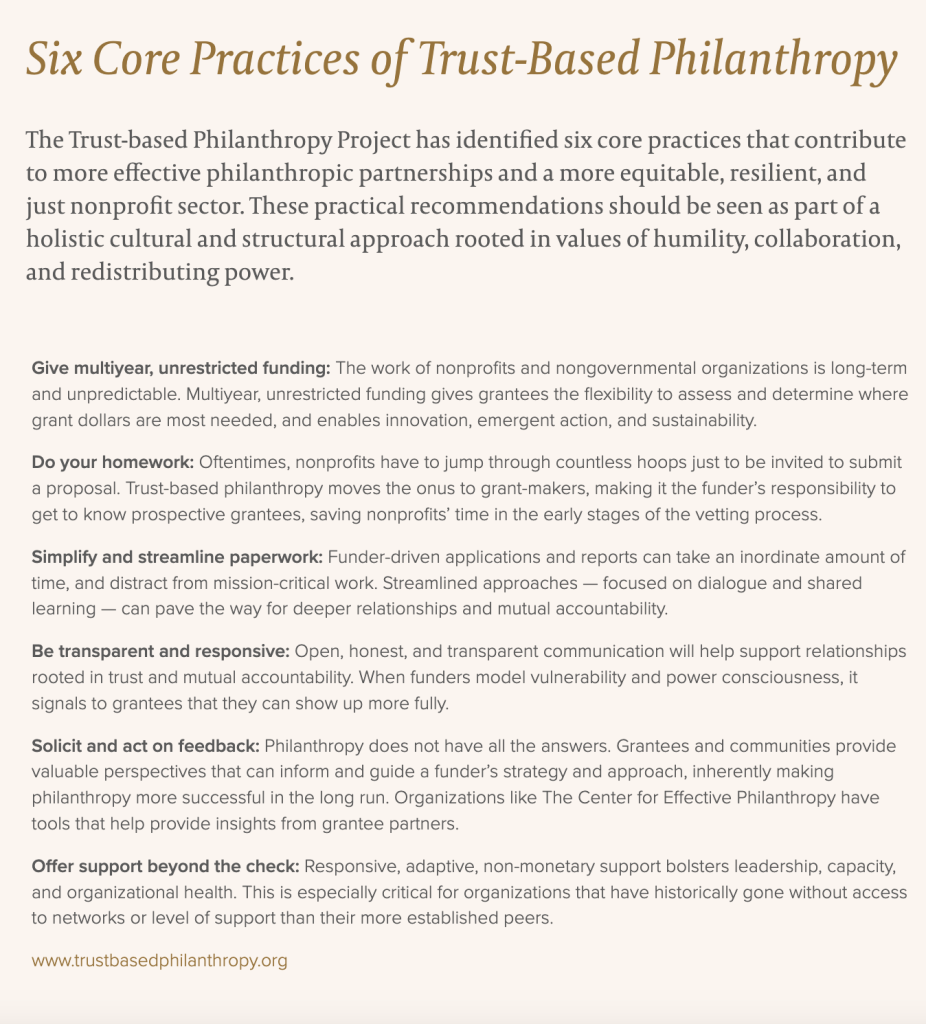Shaady Salehi, executive director of the Trust-Based Philanthropy Project, on why transparent, trusting relationships between donors and doers are key to achieving impact.
As a young nonprofit executive, I once flew across the country to meet with a new funder. I was nervous, excited, and eager to make a connection that would (hopefully) help my organization continue its work and perhaps even grow. I arrived at the foundation’s office with my best blazer on my back, a well-polished pitch in my head, glossy marketing materials in my hand, and my heart set on an honest conversation that could lead to ongoing partnership and support.
When I arrived, the receptionist told me that the funder was running behind schedule. Her assistant ushered me to her office. I waited, and waited, and waited, rehearsing my carefully planned talking points in my head. The funder finally arrived 45 minutes later, with an air of distraction and a hurried apology. She leaned against her desk, standing, with her arms crossed. “What brings you in today?” she asked, checking her watch.
In that instant, all of my hopes were dashed. With her standing over me, I felt myself crumple. The one-hour discussion I had planned turned into a rushed 15-minute pitch. I don’t even remember the words that came out of my mouth. I was demoralized.
Many nonprofit leaders I’ve spoken with have shared similar stories. Funders who don’t reply to emails from grantees they are actively funding. Funders who refuse to cover general operating expenses. Funders who require thick applications and lengthy interviews for tiny grants. Funders who want to have conversations for months — even years — asking for guidance and “picking our brains” without ever offering support. Funders who make last-minute requests that derail staff for days.
At best, this dynamic causes stress and strain on nonprofits and the leaders who run them. At worst, these common practices inhibit the ability of a nonprofit to remain focused on its work and intended impact.
In fact, a 2018 study by the Open Road Alliance revealed that nearly half of the barriers that undermine nonprofit impact are created by — you guessed it — funders.
How is this so? When a nonprofit’s time and energy are directed toward meeting funder demands, its innovation and creativity are channeled not into maximizing impact, but into pleasing funders and securing its next check.
Degrees of Trust
Data shows that these dynamics have a disproportionate impact on nonprofits led by people of color, in part because these organizations often have a harder time accessing philanthropic support. A 2020 study by The Bridgespan Group and Echoing Green quantified this disparity, finding that unrestricted net assets for Black-led nonprofits are 76% smaller than their White-led counterparts.
The tragedy of our sector is that the aspirations, mission, and potential impact of Black-led nonprofits are not 76% smaller or less important than that of White-led organizations. In a field in which the majority of nonprofit leaders are forced to work at the whims of their funders, leaders of color have to work even harder to overcome distrust and other structural barriers to access funding.
Accelerating social impact requires the people who hold the purse strings to confront — and address — the power imbalances that skew priorities and hold back leaders most proximate to the problems we all seek to address.
Nonprofit leaders have been calling for change for more than a decade, advocating for a more equitable approach that alleviates the inherent power imbalances between funders, nonprofits, and communities. Their goal: a philanthropic sector that trusts, values, and supports their leadership and expertise.
Trust-Based Philanthropy is Born
The movement for change began to gain traction in 2012 when the San Francisco-based foundation The Whitman Institute announced that it would spend down its assets over the next 10 years. The Whitman Institute looked to grantees for guidance on how to optimize its final years. Focus groups and surveys revealed two fascinating trends: 1) the recurrence of the word trust, in reference to how valuable (and rare) it was to feel trusted by a funder, and 2) a resounding recommendation that the foundation should encourage other funders to embrace its intentionally less burdensome approach to grantmaking.
And thus, “trust-based philanthropy” was conceived. The Whitman Institute’s leadership began to convene funders to discuss the benefits of a philanthropic approach based on partnership and service rather than enforcement and control. They called on funders to recognize their inherent biases around those they deemed trustworthy and deserving of support.
The movement took off when two unprecedented and historic challenges presented a dramatic awakening for many in philanthropy.
First came the COVID-19 pandemic. Recognizing the need to give nonprofits flexibility during the crisis, funders across the globe began to unrestrict previously restricted grants. They extended grant deadlines. They lifted reporting requirements. Some even offered additional emergency funding. Suddenly, funders around the world were practicing what looked a lot like trust-based philanthropy. And it didn’t feel like a run on the bank. Instead, it felt like a necessary partnership in response to a historic challenge.
Then, in May 2020, George Floyd, an unarmed Black man, was murdered by police — and our society’s complicity in racial inequity and structural injustice became stark. For many funders, the majority of whom are non-Black, it became clear that addressing these deeply embedded racial inequities requires listening to, resourcing, and trusting leaders who are Black, Indigenous, and people of color. It also prompted reexamination of how our systems, structures, and decision-making protocols have overlooked and excluded those who are in most need of support.
Today, the trauma and heartbreak of 2020 is accelerating a paradigm shift toward trust-based philanthropy that is expanding impact.
If we want to tackle some of our society’s most pervasive and deeply rooted problems, it must be informed and led by those who are closest to the issues at hand. And if funders truly want to contribute to social impact, they must be willing to recognize that sometimes the biggest barrier to impact is philanthropy itself.
Accelerating Impact at the Speed of Trust
Consider how the shift has supercharged the effort of bi3, a philanthropic initiative to transform health by addressing infant and maternal health in Cincinnati, Ohio. After the initiative moved away from the standard quarterly reporting and embraced phone calls with grantees a few years ago, they learned something surprising. They heard from doctors and nurses at one of their grantee clinics who were deeply frustrated. It was extremely challenging, they shared, to make progress on maternal and newborn health in low-income areas when new mothers lost their Medicaid coverage 60 days after birth. The loss of health care coverage meant that their patients stopped accessing medical care. This insight helped b13 take on this systematic barrier to infant and maternal health. It identified an advocacy partner and provided them with resources to launch a targeted campaign to extend postpartum Medicaid coverage to one year. Thanks to their work, as of April 2022, women across Ohio are now eligible for one full year of postpartum coverage, a critical step to improved maternal and infant health for all Ohioans.
San Francisco’s Hellman Collaborative Change Initiative also simplified its application and reporting requirements and began to build deeper relationships with its grantees who work to improve health, education, and opportunity in the Bay Area. Those relationships proved invaluable during the pandemic, when grantee partners told them that food insecurity was acute in East Oakland. The grantee partners recommended three organizations who were well positioned to resolve the crisis effectively and quickly. The Initiative responded swiftly with unrestricted grants to the recommended organizations. Insights from grantees have been so helpful that Initiative leaders have now invited their grantee partners to help inform the Initiative’s new strategic plan.
It is clear that the path to greater impact lies not in more rigorous reporting or application requirements but in more resilient and responsive organizations, who have funders’ trust.
Funders that have committed to trust-based philanthropy don’t necessarily have it all figured out. However, they have figured out that philanthropy’s success is inherently tied to their ability to build honest and transparent relationships with the organizations they support. If we want to tackle some of our society’s most pervasive and deeply rooted problems, it must be informed and led by those who are closest to the issues at hand. And if funders truly want to contribute to social impact, they must be willing to recognize that sometimes the biggest barrier to impact is philanthropy itself.
Shaady Salehi
Shaady Salehi is a strategist, facilitator, and network builder who has been working in the nonprofit sector since 2003. She currently serves as the executive director of the Trust-Based Philanthropy Project, a learning and advocacy initiative to advance more equitable and power-conscious practices in philanthropy. Her career in the nonprofit sector has spanned many roles — from department head, to executive director, board member, and consultant — and her main body of work has centered on using film, media, and strategic communications to advance social change.
This article was originally published in Social Investor magazine, a publication by Chandler Foundation looking at the challenges of social impact, featuring insights from a diverse range of social change leaders.







Comments (0)